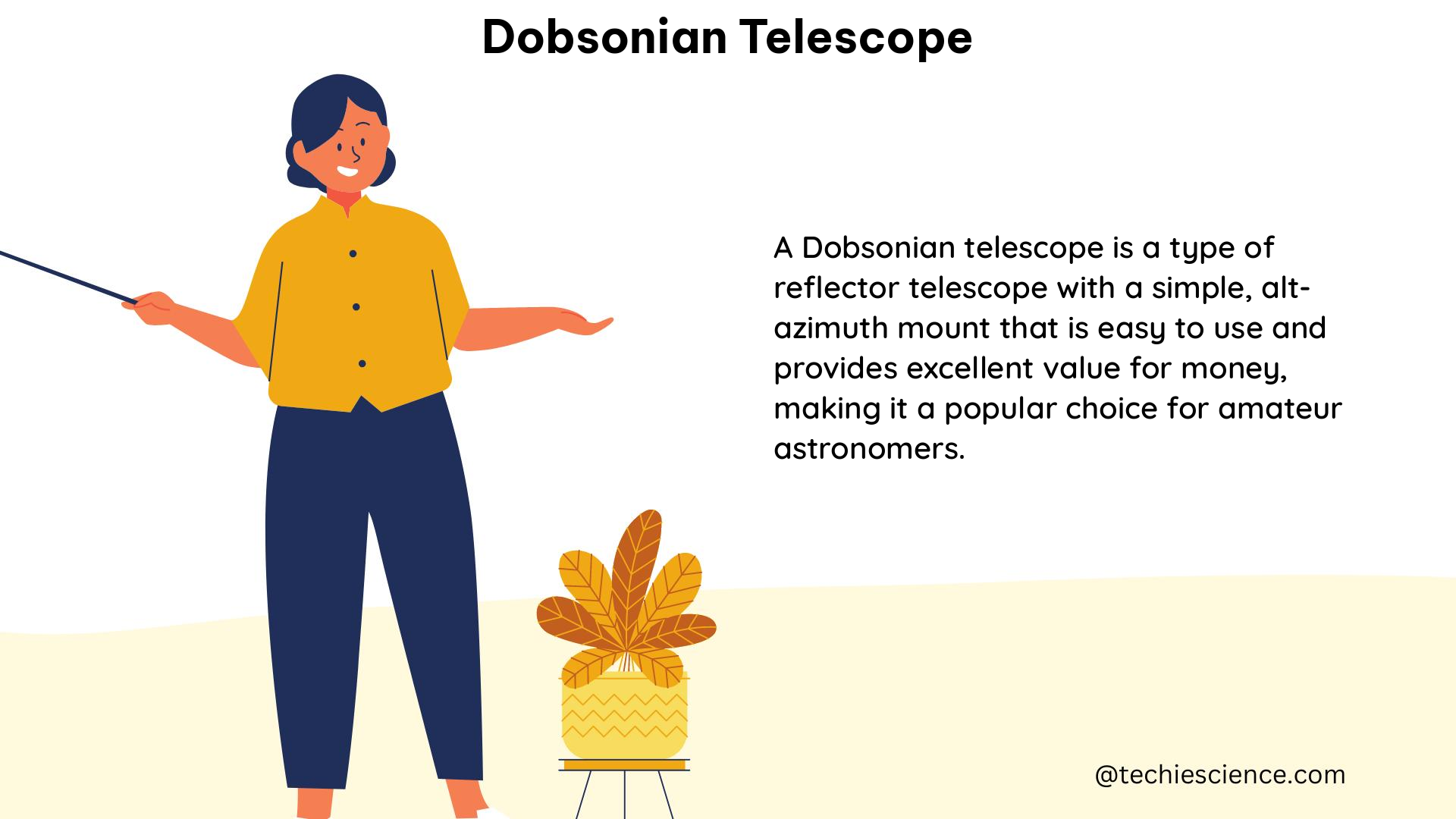The Dobsonian telescope is a type of Newtonian reflector telescope that is renowned for its simplicity, ease of use, and exceptional light-gathering capabilities. This comprehensive guide will delve into the technical details and quantifiable data points that make the Dobsonian telescope a popular choice among amateur and professional astronomers alike.
Aperture: The Key to Brightness and Detail
The aperture of a Dobsonian telescope, which is the diameter of the primary mirror, is a crucial factor in determining the amount of light the telescope can collect. Dobsonian telescopes come in a wide range of aperture sizes, typically ranging from 6 inches to 30 inches or more. The aperture size is directly proportional to the telescope’s light-gathering power, as described by the formula:
Light-gathering power = (Aperture diameter)^2
For example, a 12-inch Dobsonian telescope has a light-gathering power that is four times greater than a 6-inch Dobsonian telescope, as the aperture diameter has doubled. This increased light-gathering power allows for brighter and more detailed views of celestial objects, such as galaxies, nebulae, and even faint deep-sky objects.
Focal Length and Focal Ratio: Balancing Magnification and Field of View

The focal length of a Dobsonian telescope is the distance between the primary mirror and the focal point, where the image is formed. The focal length, in combination with the eyepiece, determines the magnification of the telescope. Dobsonian telescopes typically have a fast focal ratio, such as f/4 or f/5, which provides a wide field of view and makes it easier to locate and track celestial objects.
The focal ratio (f/ratio) of a Dobsonian telescope is the ratio of the focal length to the aperture. A lower f/ratio (e.g., f/4 or f/5) provides a wider field of view, which is beneficial for observing larger objects like galaxies and nebulae. Conversely, a higher f/ratio (e.g., f/10) provides a narrower field of view, making it more suitable for observing smaller objects like planets and the Moon.
The relationship between focal length and aperture can be expressed as:
Focal ratio = Focal length / Aperture
For example, a Dobsonian telescope with a 48-inch focal length and a 12-inch aperture would have an f/ratio of 4 (48 inches / 12 inches = 4).
Weight and Mount: Balancing Portability and Stability
Dobsonian telescopes can be quite heavy, with some models weighing over 100 pounds. The weight of the telescope is determined by the size of the primary mirror, the materials used in the construction, and the type of mount used.
Dobsonian telescopes employ a simple alt-azimuth mount, which allows the telescope to move up and down (altitude) and left and right (azimuth). This type of mount is easy to use and does not require complex alignment or adjustment, making it a popular choice for amateur astronomers.
The alt-azimuth mount works on the principle of two perpendicular axes of rotation, allowing the telescope to be pointed in any direction in the sky. The altitude axis controls the up-and-down motion, while the azimuth axis controls the left-and-right motion. This simple design, combined with the large aperture of Dobsonian telescopes, makes them highly portable and easy to set up, even for observers with limited experience.
Eyepieces and Focuser: Customizing the Viewing Experience
Dobsonian telescopes typically come with one or more eyepieces, which determine the magnification of the telescope. The eyepiece is inserted into the focuser, a device that holds the eyepiece in place and allows it to be adjusted for focus.
The magnification of a telescope is calculated by dividing the focal length of the telescope by the focal length of the eyepiece:
Magnification = Telescope focal length / Eyepiece focal length
For example, a Dobsonian telescope with a 48-inch focal length and an eyepiece with a 20mm focal length would have a magnification of 48 inches / 20mm = 24x.
Dobsonian telescope owners can experiment with different eyepieces to achieve the desired magnification and field of view for their observing needs. A wide range of eyepiece focal lengths, from low-power (e.g., 40mm) to high-power (e.g., 5mm), allows for versatile observing experiences.
Finderscope: Aiming the Telescope with Precision
Dobsonian telescopes often come equipped with a finderscope, a small auxiliary telescope mounted on the main telescope. The finderscope serves as a sighting tool, helping the observer quickly locate and center celestial objects in the main telescope’s field of view.
Finderscopes typically have a lower magnification than the main telescope, making it easier to acquire and track targets. The finderscope’s reticle, or crosshairs, provides a reference point for aligning the telescope with the desired object.
The relationship between the finderscope’s and the main telescope’s fields of view can be expressed as:
Finderscope field of view = Main telescope field of view / Finderscope magnification
For example, if a Dobsonian telescope has a 2-degree field of view and the finderscope has a magnification of 8x, the finderscope’s field of view would be 2 degrees / 8 = 0.25 degrees.
Optical Coatings and Mirrors: Enhancing Light Transmission and Reflection
The primary mirror of a Dobsonian telescope is typically made of glass or a lightweight material like Pyrex, and it is coated with a highly reflective material, such as aluminum or silver, to maximize light reflection.
The reflectivity of the primary mirror is an important factor in the telescope’s overall light-gathering and image quality. Aluminum coatings can achieve a reflectivity of around 90-92%, while enhanced coatings like protected silver can reach up to 98% reflectivity.
Additionally, the secondary mirror, which reflects the light from the primary mirror to the eyepiece, is also coated to enhance light transmission. Anti-reflective coatings on the secondary mirror and the eyepiece lenses can further improve the telescope’s overall optical efficiency.
Collimation: Aligning the Optical Components
Proper collimation, the alignment of the primary and secondary mirrors, is crucial for achieving optimal performance in a Dobsonian telescope. Misaligned mirrors can result in distorted, blurry, or off-center images.
The collimation process involves adjusting the tilt and position of the secondary mirror to ensure that the light path from the primary mirror is correctly focused on the eyepiece. This can be done using a collimation tool, such as a Cheshire eyepiece or a laser collimator, and following a step-by-step collimation procedure.
Maintaining proper collimation is essential for obtaining the best possible image quality and resolving power from your Dobsonian telescope.
Accessories and Upgrades: Enhancing the Observing Experience
Dobsonian telescope owners can further enhance their observing experience by investing in various accessories and upgrades. Some popular options include:
- Eyepiece sets: A range of eyepieces with different focal lengths can provide a variety of magnification options and fields of view.
- Barlow lenses: These accessories can double or triple the magnification of an eyepiece, allowing for higher-power observations.
- Filters: Specialized filters, such as nebula filters or moon filters, can enhance the contrast and visibility of specific celestial objects.
- Cooling fans: These fans can help stabilize the temperature of the primary mirror, reducing air turbulence and improving image quality.
- Telrad finders: These zero-power reflex sights can provide a quick and easy way to locate targets in the sky.
- Dew shields and heaters: These accessories can prevent dew formation on the telescope’s optics, ensuring clear and unobstructed views.
By exploring these accessories and upgrades, Dobsonian telescope owners can tailor their observing setup to their specific needs and preferences, further enhancing their overall astronomical experience.
Conclusion
The Dobsonian telescope is a remarkable instrument that combines simplicity, ease of use, and exceptional light-gathering capabilities. By understanding the technical details and quantifiable data points discussed in this comprehensive guide, science students and amateur astronomers can make informed decisions when selecting and using a Dobsonian telescope.
Whether you’re a beginner or an experienced observer, the Dobsonian telescope offers a versatile and rewarding platform for exploring the wonders of the night sky. With its large aperture, wide field of view, and user-friendly design, the Dobsonian telescope continues to be a popular choice among stargazers of all levels.
Reference:
- The Dobsonian Telescope: A Practical Guide for Building Large Aperture Telescopes
- Dobsonian Telescope Designs
- How to Build a Dobsonian Telescope
- Telescope Optics: A Comprehensive Resource
- Astronomy Essentials: Understanding Telescope Aperture

Hi, I am Sanchari Chakraborty. I have done Master’s in Electronics.
I always like to explore new inventions in the field of Electronics.
I am an eager learner, currently invested in the field of Applied Optics and Photonics. I am also an active member of SPIE (International society for optics and photonics) and OSI(Optical Society of India). My articles are aimed at bringing quality science research topics to light in a simple yet informative way. Science has been evolving since time immemorial. So, I try my bit to tap into the evolution and present it to the readers.
Let’s connect through